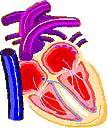|
|
| A Matter of the Heart |
Discover Of New Genes Two Genes Studied In Depth Application |

The human heart has always been regarded as the seat of emotions. In fact, it is nothing but a very rugged pump that can often work for close to a century. Nevertheless, the pump does run into problems very often. With infectious diseases increasingly under control, cardiovascular diseases have become the major cause of death and disability after age 35. In order to deal effectively with cardiovascular diseases, researchers set out to investigate their nature and what constitutes predisposition to heart diseases. Whereas in the past such investigations were largely dependent on the study of gross anatomy and physiology, over the last few decades medical scientists have adopted a much more microscopic and fundamental approach, which is expected to be more fruitful.
|
|
| How Genes Come into Play | Top |
|
Many diseases have some genetic component. Some diseases, such as sickle-cell anaemia, are caused by a change in a single base in the DNA. However, most genetically influenced diseases, including heart diseases, are more complex; they are caused by flaws in several genes. A thorough study of the genes involved in the heart is therefore required to understand the genetic basis of heart diseases. Humans are believed to have about 100,000 genes in their DNA. A gene is a kind of computer code, written by chemical bases that stretch along part of the double-helix DNA molecule. The code in a gene orders the cell to produce one and only one type of protein. Fortunately, not all 100,000 genes are expressed in the heart; typically only 10,000 to 30,000 are expressed in any one kind of tissue. So by systematically studying the 10,000 to 30,000 genes involved in the heart, it is hoped that a better set of molecular tools will be acquired for fighting heart diseases. As a possible bonus, the results might allow doctors to tell whether treatments are effective, by monitoring the genes that are expressed aberrantly.
|
|
| Discovery of New Genes | Top |
|
A group of researchers led by Dr. Mary Waye and Prof. C.Y. Lee of the Department of Biochemistry are currently engaged in such systematic studies at The Chinese University of Hong Kong. They enjoy the support of overseas collaborators, including Prof. C.C. Liew of the University of Toronto and his research assistants. The project started in 1992 with very little manpower and equipment, but in 1993, a grant of HK$766,600 was obtained from the Research Grants Council for a period of two years, and a machine crucial for the project - the automatic DNA sequencer - was purchased. The project gradually gained momentum and by early 1994 was able to produce results. The first stage of the project involved a systematic approach to identify all novel genes expressed in heart tissue. To do this, a library of cDNA clones relevant to the human heart was first obtained. A cDNA is a complementary DNA artificially produced from mRNA molecules taken from the heart. These cDNAs are then inserted into the DNA of bacteriophage lambda, which is a virus of bacteria. The recombinant materials that grow out of such a process are called 'clones'. The library of cDNA clones contain at least one DNA copy of each of the mRNA species expressed in the heart. By extracting the DNA material from the clones and amplifying its amount via polymerase chain reaction, the DNA can be purified and sequenced directly. To 'sequence' a DNA means to delineate the biochemical structure and pattern of its constituent genes. The sequences obtained were then compared with published sequences in an international database. Of the 1,000 cDNA clones randomly chosen for sequencing, 24 per cent matched with published human sequences, 10 per cent matched with mitochondria sequences (mitochondria are subcellular organelles that function as the machinery for cellular respiration), and 6 per cent matched with repetitive human sequences. But the rest, nearly 60 per cent, turned out to be novel - these are genes associated with the heart that have never been seen before.
|
|
| Two Genes Studied in Depth | Top |
|
Unfortunately, studying 600 genes would be too much of an undertaking for the research team. So they focused their effort on two novel cDNA genes of particular interest. The first, A076, contains a region the structure of which corresponds to heat shock proteins. It has been demonstrated that changes in the level and distribution of such proteins have a direct bearing on the evolution of atherosclerosis, i.e. the progression from fatty streaks to fibrous plaques that can block an artery, producing a heart attack. It is also thought that heat shock proteins are produced during stress and may protect cells by preventing damage of other important cellular proteins, or by restoring the functions and properties of damaged proteins. The other gene of interest, A0550, contains a cDNA which shares the same structural origin with zinc-binding proteins. Zinc-binding proteins may have a variety of functions including zinc transport and specific interactions with DNA, RNA or proteins.
|
|
| Application | Top |
|
Researchers hope that they can use these novel genes as probes to find suitable markers that correlate the genetic changes with human genetic diseases, thereby facilitating diagnosis of genetic heart diseases and the identification of individuals who might be prone to certain health conditions. The mysteries of the heart are being unfolded gene by gene. |
|


|
|